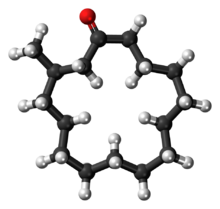Muscone
Topic: Chemistry
 From HandWiki - Reading time: 3 min
From HandWiki - Reading time: 3 min

| |

| |
| Names | |
|---|---|
| Preferred IUPAC name
(3R)-3-Methylcyclopentadecan-1-one | |
| Identifiers | |
3D model (JSmol)
|
|
| ChEMBL | |
| ChemSpider | |
| EC Number |
|
PubChem CID
|
|
| UNII | |
| |
| |
| Properties | |
| C16H30O | |
| Molar mass | 238.415 g·mol−1 |
| Density | 0.9221 g/cm3 |
| Melting point | −15 °C (5 °F; 258 K) |
| Boiling point | 328 °C (622 °F; 601 K) |
| Hazards | |
| NFPA 704 (fire diamond) | |
Except where otherwise noted, data are given for materials in their standard state (at 25 °C [77 °F], 100 kPa). | |
| Infobox references | |
Muscone is a macrocyclic ketone, an organic compound that is the primary contributor to the odor of musk. Natural muscone is obtained from musk, a glandular secretion of the musk deer, which has been used in perfumery and medicine for thousands of years. Since obtaining natural musk requires killing the endangered animal, nearly all muscone used in perfumery and for scenting consumer products today is synthetic. It has the characteristic smell of being "musky".
Chemical structure and synthesis
The chemical structure of muscone was first elucidated by Leopold Ružička. It is a 15-membered ring ketone with one methyl substituent in the 3-position. It is an oily liquid that is found naturally as the (−)-enantiomer, (R)-3-methylcyclopentadecanone. Muscone has been synthesized as the pure (−)-enantiomer as well as the racemate. It is very slightly soluble in water and miscible with alcohol.
One asymmetric synthesis of (−)-muscone begins with commercially available (+)-citronellal, and forms the 15-membered ring via ring-closing metathesis:[1]
A more recent enantioselective synthesis involves an intramolecular aldol addition/dehydration reaction of a macrocyclic diketone.[2]
Isotopologs
Isotopologs of muscone have been used in a study of the mechanism of olfaction. Global replacement of all hydrogen atoms in muscone was achieved by heating muscone in heavy water (D2O) at 150 °C in the presence of a rhodium on carbon catalyst.[3] It was found that the human musk-recognizing receptor, OR5AN1, identified using a heterologous olfactory receptor expression system and robustly responding to muscone, fails to distinguish between muscone and the so-prepared isotopolog in vitro.[3] OR5AN1 is reported to bind to muscone and related musks such as civetone through hydrogen-bond formation from tyrosine-258 along with hydrophobic interactions with surrounding aromatic residues in the receptor.[4]
References
- ↑ Kamat, V. P.; Hagiwara, H.; Katsumi, T.; Hoshi, T.; Suzuki, T.; Ando, M. (2000). "Ring Closing Metathesis Directed Synthesis of (R)-(−)-Muscone from (+)-Citronellal". Tetrahedron 56 (26): 4397–4403. doi:10.1016/S0040-4020(00)00333-1.
- ↑ Knopff, O.; Kuhne, J.; Fehr, S. (2007). "Enantioselective Intramolecular Aldol Addition/Dehydration Reaction of a Macrocyclic Diketone: Synthesis of the Musk Odorants (R)-Muscone and (R,Z)-5-Muscenone". Angew. Chem. Int. Ed. 46 (8): 1307–1310. doi:10.1002/anie.200604518. PMID 17211908.
- ↑ 3.0 3.1 Block, E. (2015). "Implausibility of the Vibrational Theory of Olfaction". Proc. Natl. Acad. Sci. USA 112 (21): E2766–E2774. doi:10.1073/pnas.1503054112. PMID 25901328. Bibcode: 2015PNAS..112E2766B.
- ↑ Ahmed, L. (2018). "Molecular Mechanism of Activation of Human Musk Receptors OR5AN1 and OR1A1 by (R)-Muscone and Diverse Other Musk-smelling Compounds". Proc. Natl. Acad. Sci. USA 115 (17): E3950–E3958. doi:10.1073/pnas.1713026115. PMID 29632183. Bibcode: 2018PNAS..115E3950A.
 |
 KSF
KSF

